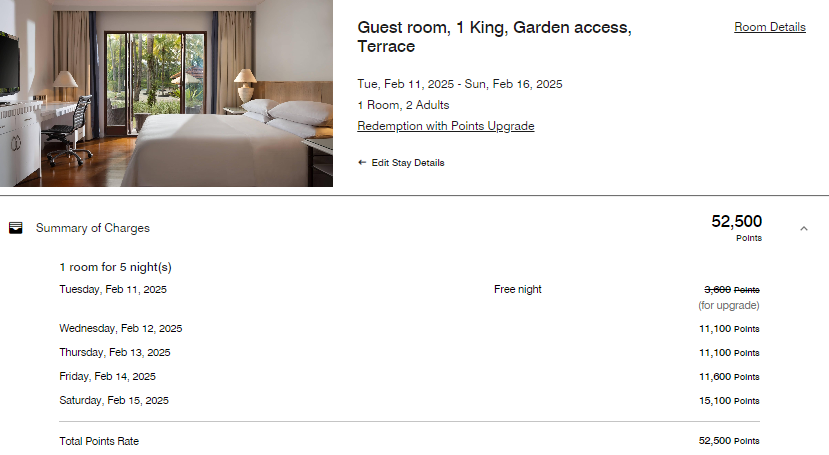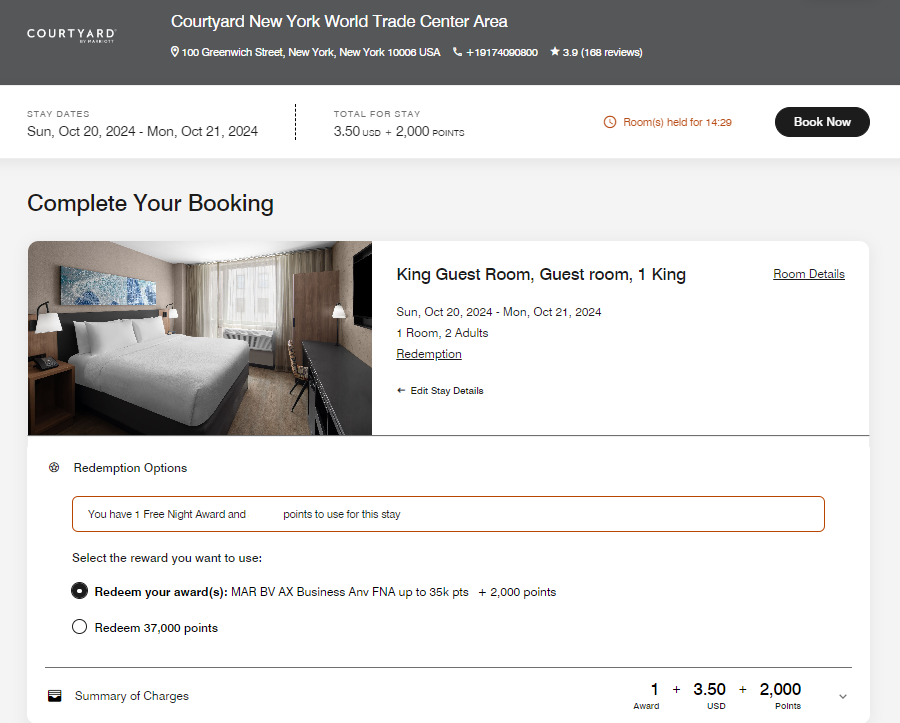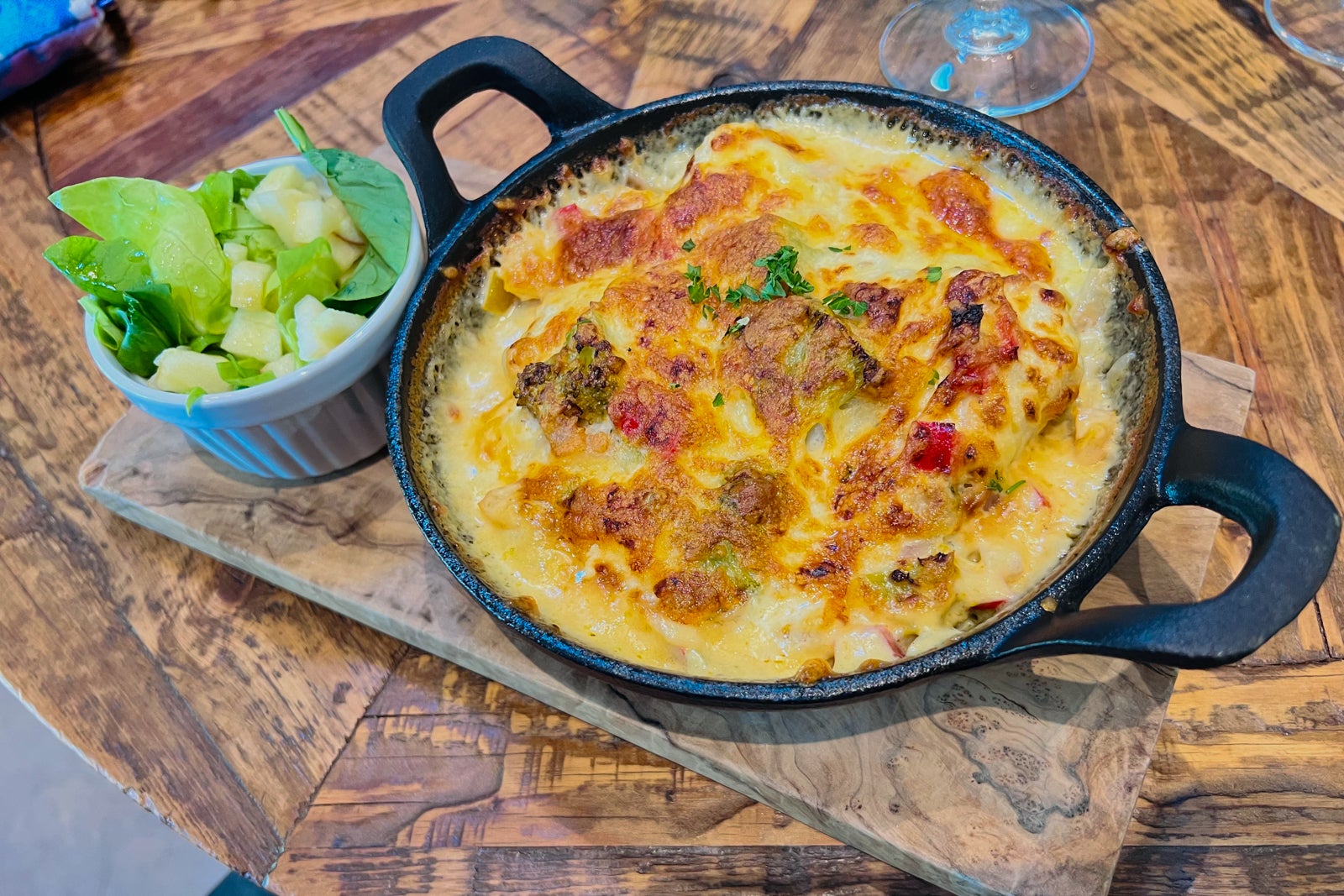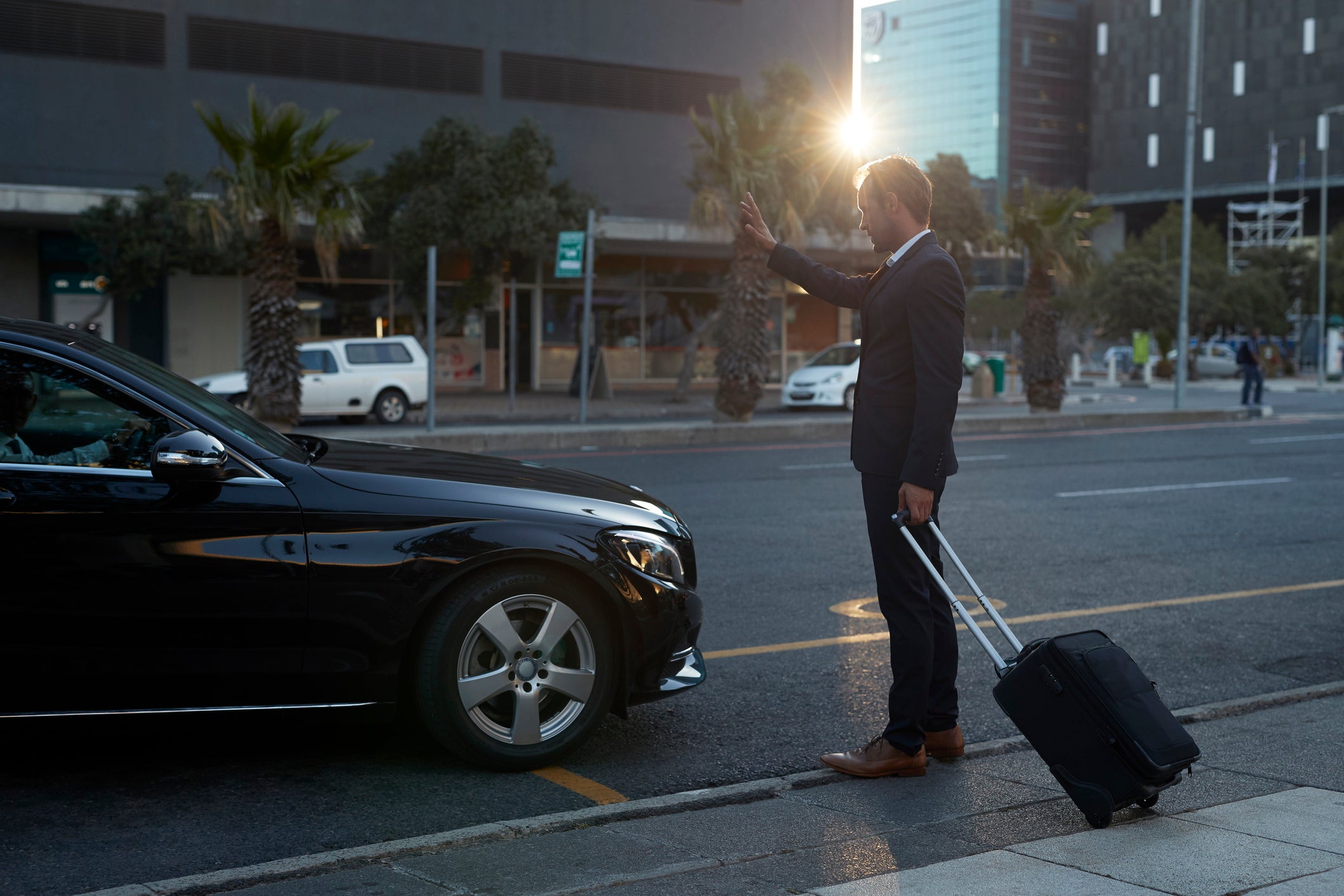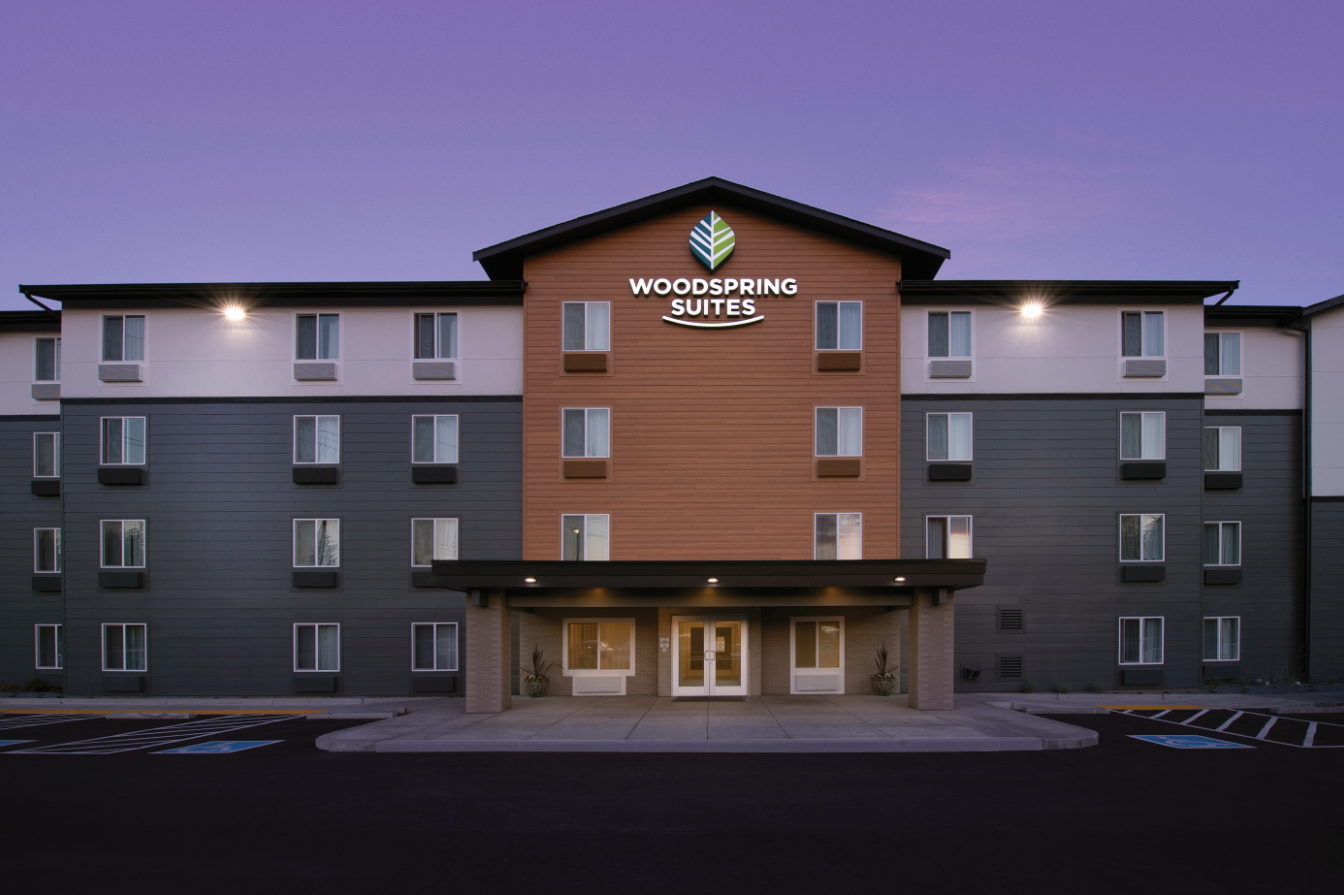Editor’s note: TPG’s Erica Silverstein accepted a free trip from Viking to sail Viking Polaris in Antarctica. The opinions expressed below are entirely hers and weren’t subject to review by the line.
Viking Polaris is the ship that bucket list dreams are made of.
The sturdy, 378-passenger ship in the Viking fleet is rated Polar Class 6, so it can take you to the ends of the Earth, no problem. It’s tricked out with Zodiacs, two submersibles, kayaks and a speed boat, so remote islands and narrow bays won’t keep you from close encounters with wildlife and nature.
Checking off worldwide wish-list destinations like Antarctica, the Arctic and the Great Lakes also comes with style. The ship boasts four onboard restaurants and a breathtaking spa that’s open to all. Cabins are cozy and spacious with seating nooks by floor-to-ceiling windows, large (for a ship) bathrooms with heated floors and thoughtful touches for the perfect adventure, like a drying closet and two sets of binoculars.
Public lounge areas are so inviting, with comfortable seating and light-filled spaces thanks to tons of windows, that you’ll be glad to kick back with a book, a puzzle or a drink after an incredible experience ashore. And the crew members do all they can to make you feel right at home, remembering your name and greeting you warmly whenever they see you.
Viking might be inspired by Nordic sailors of yore, who explored the world in their bare-bones longships — or the rugged 20th-century explorers whose portraits line the walls of the ship — but Viking Polaris’ creature comforts would make all those hardy men and women rethink their travel choices. You won’t regret yours if you choose to make this gorgeous little ship your home base for vacation adventure.
Overview of Viking Polaris
At 30,158 tons, Viking Polaris is small by ocean ship standards. The biggest megaships are eight times larger. But it’s actually the largest vessel in the adventure-focused subset of ocean ships known as expedition ships, and it holds an unusually large number of passengers for such a vessel: 378 spread across 189 cabins and suites.
This means that while you’ll enjoy the intimacy and personalized service of a small ship when you’re on board, not to mention the additional onboard venues the extra space allows, you will need to wait your turn when going ashore in some destinations such as Antarctica, where only 100 people are allowed onshore at each landing site at a time.
In addition, the ship is for adults only; you must be 18 years or older to sail. Not that you should expect a bunch of partying 20-somethings on board. Viking caters to a 55+ crowd, and the majority of its guests are retirees in their 60s and 70s. The cruise line also has a huge fan club. More than half the guests on my Antarctica cruise were repeat passengers who adore Viking’s ocean and river cruises, and you’ll find that to be true on most sailings.
Related: Viking Explorer Society cruise loyalty program: Everything you need to know
Viking positions its expedition vessels between the over-the-top, completely all-inclusive luxury ships that go to off-the-beaten-path places such as Antarctica and the hardier, no-frills classic expedition ships. It focuses on a comfortable onboard environment with accessible adventure options.
The ship is upscale, but not ornate or stuffy, and its public spaces are inviting rather than impressive. Think of the ship as the living room designed by your friend with good taste instead of the formal sitting area where you’re afraid to touch the expensive decorations.
Many amenities are included in the fare — Wi-Fi; all dining, wine and beer with lunch and dinner; a gorgeous thermal suite with a pool and hot and cold therapies; kayak and special operations boat tours; two-layer jackets to keep; and boots and waterproof pants to borrow in polar cruise regions — but you will still need to pay extra for cocktails (either a la carte or with a beverage package), gratuities, spa treatments and submarine rides.
Of the 250-plus crew members on board, 20-plus are expedition staff: scientists, specialists (biologists, geologists, naturalists, etc.), mountain guides and kayak guides. They are on board to scout and set up landing sites, lead kayak tours, conduct science experiments from the ship, spot wildlife, and give lectures about the flora, fauna and geography of the area. They’re generally helpful individuals, happy to answer your questions and take photos of both guests and wildlife to share.
The ship has seven passenger decks, with the lowest, Deck A, the Zodiac and special operations boat loading zone, and the highest, Deck 6, being an open deck. (The highest Deck 7 is off limits except during the weather balloon release party.) The ship is small and it doesn’t take long to get anywhere, though it does take a few days to get the hang of where things are on board and how to get from point A to point B. Unlike on many ocean cruise ships, you might need to walk down passenger corridors to reach certain lounges.
The ship is unusual in that it has an operational science lab on board where the ship’s research scientists collect data to share with its global partners (such as NOAA and the University of Western Australia). In addition to the Zodiacs and kayaks common on expedition ships, Viking Polaris also carries two six-passenger yellow submersibles (playfully named George and Ringo — get it?) and a Special Operations Boat (a 12-seater speed boat with surprisingly comfortable seats and easy boarding).
All these vessels are stored in The Hangar, a water-level storage area that speeds up the deployment time of all the ship’s watercraft. Here, too, the cruise line has created a spacious and comfortable boarding area that functions without gangways and with the latest biosecurity technology, such as a boot washing machine. The setup makes it easier to both get on and off ships and keep Antarctica clean.
Related: The 3 types of Viking ships, explained
What I loved about Viking Polaris
The Nordic Spa
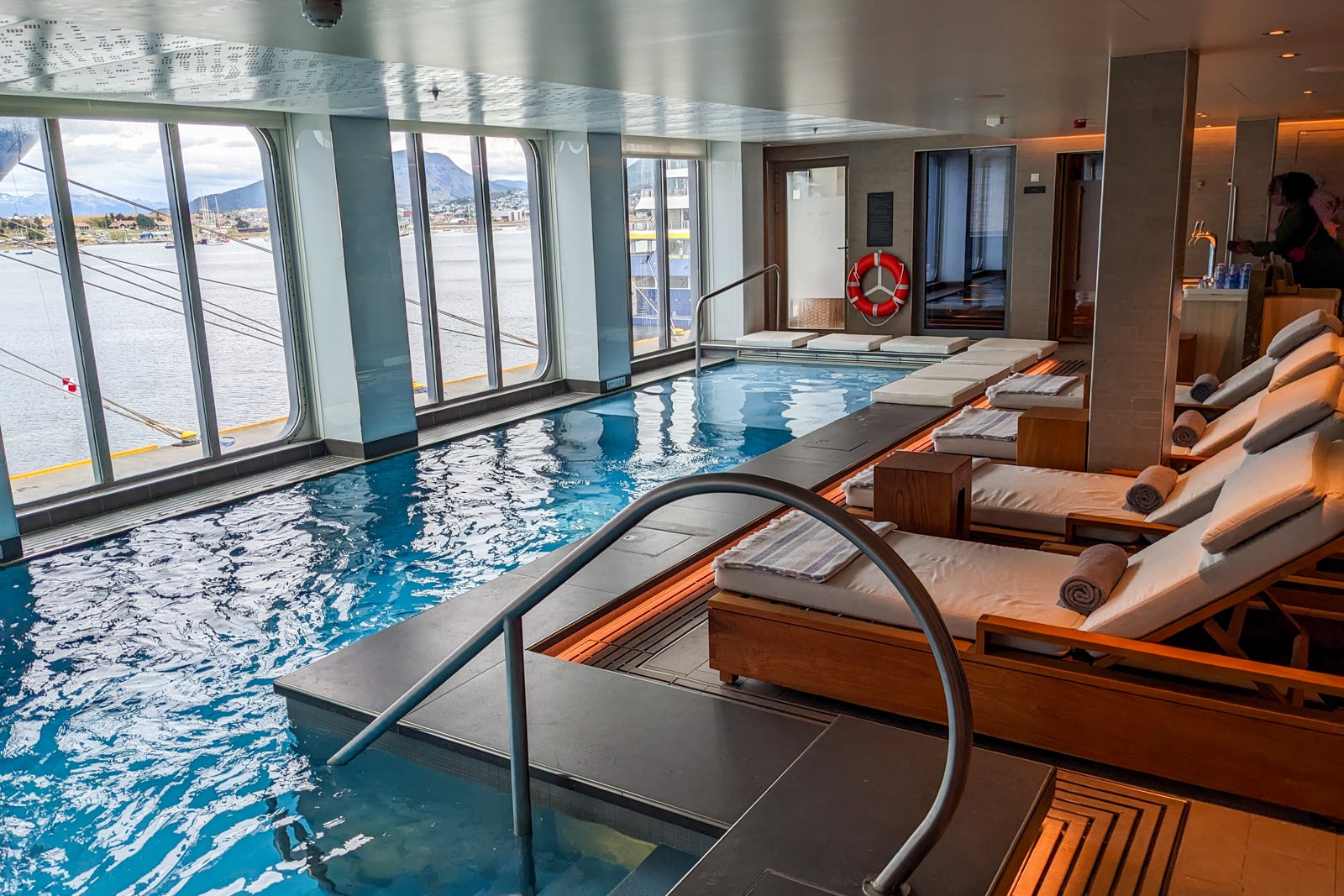
You don’t expect a full-blown gorgeous spa when you’re adventuring to Antarctica, but Viking Polaris provides not only a beautiful facility but also one that brings the destination in. Floor-to-ceiling windows in the salon and thermal suite area allow you to watch for whales or seals as you enjoy a pedicure or soak in a hot tub.
Even better, the thermal suite is free for anyone to use, so if you get chilled on a wet kayak ride, you can warm up again in the heated pool or pamper tired muscles with a mix of hot and cold therapies. (If you’ve never dumped a bucket of cold water on your head after 15 minutes in a dry sauna or rubbed snow on your body in a steam room, I highly recommend trying it.)
The two-room fitness center is also larger than I expected for an expedition ship and enabled me to keep up my workout routine every morning.
Big kudos go to the spa staff, who are super sweet and helpful. Igor tailored my personal training session to my specific requirements and body needs, rather than giving me some standard plan. Joksim led a surprisingly intense (for a cruise ship) yoga session and then gave me an incredible massage a few days later, working out every knot from my neck to my feet.
If nothing else, stop by the spa reception desk daily to grab an inspirational quote — almost like a fortune cookie — from the bowl of colored cards. It will set the tone for your day.
Safety protocols

I admit I was a tad nervous about the thought of sailing to a place as remote as Antarctica. What if we got stranded ashore during a landing? What if the Zodiac broke down halfway back to the ship?
While any expedition cruise involves a certain degree of risk, the Viking crew members put me at ease with the knowledge that they’ve prepared for every possibility. Two of the expedition guides even led a briefing about the ship’s safety protocols. We learned that the team brings ashore a ton of survival gear at every landing, including tents, thermal blankets, food and water rations, a desalination machine, a satellite phone, crevasse extraction equipment and even a portable toilet. (The latter is only used for true emergencies, so use your cabin bathroom before you head off the ship.)
Zodiac, SOB and submarine drivers are always in radio contact with each other and the ship, and they stay far away from marine animals and icebergs (which could potentially tip over and cause trouble). The crew gives guests clear instructions about how to get in and out of the ship’s boats and someone is always there to give a hand.
All cruise ships in Antarctica follow the International Association of Antarctica Tour Operators’ rules for safe and environmentally responsible tourism. Viking Polaris’s crew takes IAATO protocols seriously and works diligently to keep Antarctica pristine.
They sanitize boots going to and from shore, as well as the walking poles they provide, and advise guests against bringing anything unnecessary (snacks, tissues, etc.) to shore so nothing unsanitary ever touches the ground on landings. They even checked and vacuumed all the expedition gear we brought from home, including hats, gloves, goggles and camera bags.
The ship itself is built with all kinds of redundant systems, water-tight doors, and fire-detecting and -fighting equipment. It also carries “ice cubes,” large floating boxes filled with group survival gear for up to five days should the ship have to be abandoned.
It’s unlikely that something will go wrong on your cruise, but it’s comforting to know that the ship and crew are totally prepared for nearly any emergency.
The crew

Every cruise line will tell you its crew is the best, but the friendliness and helpfulness of Viking Polaris’ crew are palpable from the moment you step on board. Crew members you never met somehow know your name and say hello every time you pass them on board. My cabin stewards always pop out when we walk down the hallway and ask us about our day. They didn’t even bat an eye when my travel companion and I had to try on five expedition jacket sizes to find the right fit.
The dining staff goes above and beyond; Santosh asked us what food we liked on the first day, and had our Indian chickpea curry waiting for us the very next day. One member of the dining team not only fetched a specific flavor of ice cream from the galley for my friend but brought her a second bowl the following day without being asked. The restaurant manager personally reached out and sent me a plate of desserts the day I was sick and holed up in my cabin.
Whenever there are a lot of people wildlife watching on the outer decks, a crew member always seems to turn up with cocktails or spiked warm beverages. What seemed like the entire housekeeping team showed up to the cruise’s dance party one evening and unabashedly boogied down to get guests on the dance floor.
The expedition team members are always happy to answer questions, take your photo or lend a helping hand, and their lectures are always funny and engaging, even if the topic is dry. I was also impressed at the way they set expectations and rules for the guests in a lighthearted, digestible way without getting preachy or patronizing.
The crew absolutely set the tone for a friendly onboard ambience and it makes the long trip that much more enjoyable.
What I didn’t love about Viking Polaris
Lack of announcements
I’ve been on enough high-end cruises to know that the nicer ships don’t like to pipe announcements into your cabin. However, I’d love a bit more communication from the bridge on Viking Polaris.
We missed the captain’s one daily announcement almost every evening because we were inside our room and couldn’t hear it. It’s only when one of us would say, “Is someone talking in the hallway? Oh, wait, it’s the captain!” that we would make a mad dash across the room to open the door to catch the last 15 seconds of whatever he was saying about the weather and the sail ahead.
I’d love a bell or some kind of alert to open our door, even if the announcement itself isn’t piped into the room.
I was also surprised to note that Viking crew members almost never make the “whales off the starboard bow” announcements to alert passengers to wildlife viewing opportunities. I was chagrined when I learned that I had missed some active whales because I was attending an indoor briefing and had no idea that anything interesting was happening out of doors.
Schedule feature in the app
I love a good cruise ship app; it makes navigating a ship and the daily schedule so easy. Viking’s app has many useful features, including your ship’s deck plans, the daily activity schedule, the ability to make reservations and even a photo download section.
However, I heard the same complaint over and over about one aspect of the app: There is no schedule view that allows you to superimpose your reservations (spa, dinner, landings, boat rides) with the onboard activities.
That might not seem like a big deal, but expedition cruises are surprisingly busy. On any day, I might have scheduled a landing and a kayaking tour, but don’t want to miss the science lecture back on the ship. I was constantly flipping back and forth between the two separate schedules, trying to time my bookings correctly.
Other cruise line apps have a “favorite” feature, where you can select the onboard activities you don’t want to miss and add them to a personal calendar that also contains your bookings and reservations. I’d love to see Viking add this as a feature to its app.
Viking Polaris cabins and suites

On Viking Polaris, you’ll either stay in a balcony cabin or a suite. Regular and deluxe balcony cabins are essentially identical, except that the deluxe version is on decks 3 and 4 and comes with additional priority reservations, while the regular version is on the lower Deck 2.
Lower-category suites (junior suites and penthouses) are also on Deck 4, while the top-tier suites, Explorer Suites and the one Owner’s Suite, are on Deck 6.
The ship only has two Americans with Disabilities Act-compliant/wheelchair-accessible cabins; both are junior suites on Deck 4.
If you’re accustomed to ocean cruising, you’ll notice that the balconies on Viking Polaris are not your standard verandah external to the ship. Instead, they are a style employed by many river ships (and some new Royal Caribbean, Celebrity Cruises and Atlas Ocean Voyages ships), where the entire external wall of your cabin is made up of two glass window panes. With the touch of a button, the top pane slides down (like a car window) and your room becomes the balcony, with fresh air wafting in. You can even lean on the lip of the bottom pane of glass, or rest your coffee cup on it, as if it were a balcony railing.
Blackout shades can also come down at the touch of a button, but if you just need to block the sun a little, a gauzy curtain can be drawn across manually.
This style of room works well in cold polar regions where you are unlikely to sit out on a balcony for long, but do want to bring in fresh air from time to time or take a photo without a window in the way.
I was a big fan of our 215-square-foot Deluxe Balcony cabin because it felt cozy without being cramped. In Viking style, its design has Scandinavian influences with blond woods, fairly minimalist furnishings and a homey (rather than hotel-like) feel.





My favorite aspect of the cabin was the small L-shaped leather couch, tucked into a corner behind the shelving unit that separates the sleeping area from the sitting/desk area. Instead of feeling like the sitting area is smaller than the ones found on other ships, it becomes an inviting nook where you can curl up with a book while admiring the view. The coffee table comes in handy when you order room service.
The desk/vanity across from it looks like a simple tabletop but has two secrets. One is, the top lifts to reveal a storage area for jewelry and other small items, and two is that its X-shaped legs are useful for removing stuck-on expedition boots (move the chair so you can stick your foot through the top of the X and use it as leverage to pull the tight boot off).
The sitting area is smaller than you might expect because more space is smartly devoted to the dressing area on the other side of your bed. Here, you’ll find an L-shaped wardrobe with two hanging racks, two large drawers, two small drawers, a top shelf, two small shelves, a cubby for shoes and the safe. A hair dryer, bathrobes and slippers are provided for your onboard use.
The two sides of the closet open from the middle and can be tricky to pull open. One cruiser reported draping hand towels over the top to keep the doors slightly ajar to make them easier to open with her arthritic fingers.
The wardrobe is spacious, but my travel companion and I brought so much extra gear for our two-week Antarctica cruise (more medicine than I usually bring, long underwear and thick wool socks, etc.) that we maxed out the drawer space in the cabin and would have been happy with an additional drawer or two. For example, I kept all my warm-weather accessories (hats, gloves, goggles, etc.) in a bag on the closet floor because I didn’t have a drawer to store them.
Next to the wardrobe is a brilliant addition on Viking’s part — a drying closet. Cruisers on Viking Polaris keep all of their Viking-provided outdoor gear (boots, waterproof pants, two-layer jackets) in their cabins. If they, or other items, get wet on outings, you hang them up in the drying closet and push a button to turn on the heat, and they dry out before your next adventure ashore.

Pro tip: Check the drying closet regularly to make sure the heating element is still on. It does turn off eventually, and you’ll need to hit the button again if your drenched belongings aren’t dry yet.
Other nice touches in the cabin include a carafe of water, a minifridge with complimentary soft drinks refilled daily, a Nespresso coffee machine, a corkscrew, small snacks (bags of nuts and milk chocolate), two pairs of binoculars for use during the cruise and a few books themed to polar exploration. The room’s phone is on the desk, as are Quiet Vox headsets for use on tours (these aren’t used much in Antarctica).
The twin beds can be pushed together into a king, and the woolen throw blankets at the ends are a nice touch, especially if you want to snuggle on the couch with the window open. The movable nightstands each have one drawer and an outlet with a 110-volt, 220-volt, USB and USB-C outlet, as well as a wireless charging station. Each side of the bed has a reading light and a bedside light on the leather headboard.
The 55-inch interactive TV is hung on the wall opposite the bed. It has live TV channels, as well as free on-demand movies, a Viking channel to watch lectures and briefings you missed, and information about your cruise, personal schedule and onboard account. You can also make dinner, spa and shore excursion reservations via the TV.
I would have loved a couple of metal hooks on the wall, but you can bring your own because the textured walls are magnetic (but not the wood veneers outside the bathroom).


The bathroom is lovely, both for the spacious shower with a long ledge for storing toiletries or propping up a foot when shaving and for its heated floors (good for warming your toes and also for drying wet gloves). The glass shelves are small, but two generous drawers and shelf space below should accommodate all your toiletries.
Viking provides its own Freya brand of shampoo, conditioner, body wash, hand cream and body lotion in large 2.7-ounce bottles, as well as 30 SPF sunscreen, two sun-protection lip balms, shower caps, vanity kits and bar soap. In the bathroom, you’ll also find a shaver outlet, tissue box, cups and a toothbrush holder.
Related: Viking cruise cabins and suites: A guide to everything you want to know
Viking Polaris restaurants and bars

Viking Polaris is a small ship with a big appetite; it features four distinct dining venues plus room service. Meals at all restaurants on Viking Polaris are included in your cruise fare.
The restaurants are inspired by the cruise line’s Norwegian heritage, so you’ll find more smoked fish and Scandinavian pastries than you will on most other cruise lines. For a true Norwegian dining experience, you’ll want to spend time at Mamsen’s, where you can nibble on Norwegian specialties, such as waffles topped with brown cheese and hot dogs on flatbread.
Note that while vegetarian dishes are available at every meal on board, Polaris is definitely a ship that focuses on meat more than vegetables and vegetarian proteins. Gluten-free diners appear to be well taken care of; the bakery even posts a list of all the gluten-free bread products available (including pancakes, waffles and pizza).
On Viking Polaris, beer, wine and soft drinks at lunch and dinner are complimentary. During special events, such as sailaway on embarkation day, or arrival at Antarctica, the crew might come around with trays of complimentary cocktails. You can choose to purchase the Silver Spirits beverage package if you plan to order more than a drink or two daily, or you can pay for individual drinks a la carte.
Restaurants

On expedition voyages, the World Cafe buffet venue is the most popular eatery. It’s open for breakfast, lunch and dinner and is appealing for its variety of meal choices and its casual dress code. When you’re in and out of cold-weather layers, sometimes you simply don’t feel like dressing up for a formal meal.
Breakfast has everything you need to fuel up for the day, from healthy options like a made-to-order omelet station, yogurt, fruit and muesli to more decadent choices like pastries, breakfast bread pudding and pancakes. True to Viking’s Nordic tradition, morning options also include a selection of smoked fish, deli meats and cheeses. Waiters will bring you tea, hot chocolate and juice; each table is already set up with coffee.
At lunch, you’ll find a selection of hot food, usually including a carving station with a featured protein, a soup, pasta and some kind of fish and vegetarian option. The salad bar has a good selection of fixin’s (though it’s lacking in protein) plus a few cheeses daily.
Carbo-load at the bakery, where you’ll find breads (including soft pretzels), pizza (try the Norwegian goat cheese version), daily hot sandwiches, cookies and other desserts. Don’t miss the gelato stations with toppings bar or the made-to-order counter with new dishes daily, such as a fajita bar.




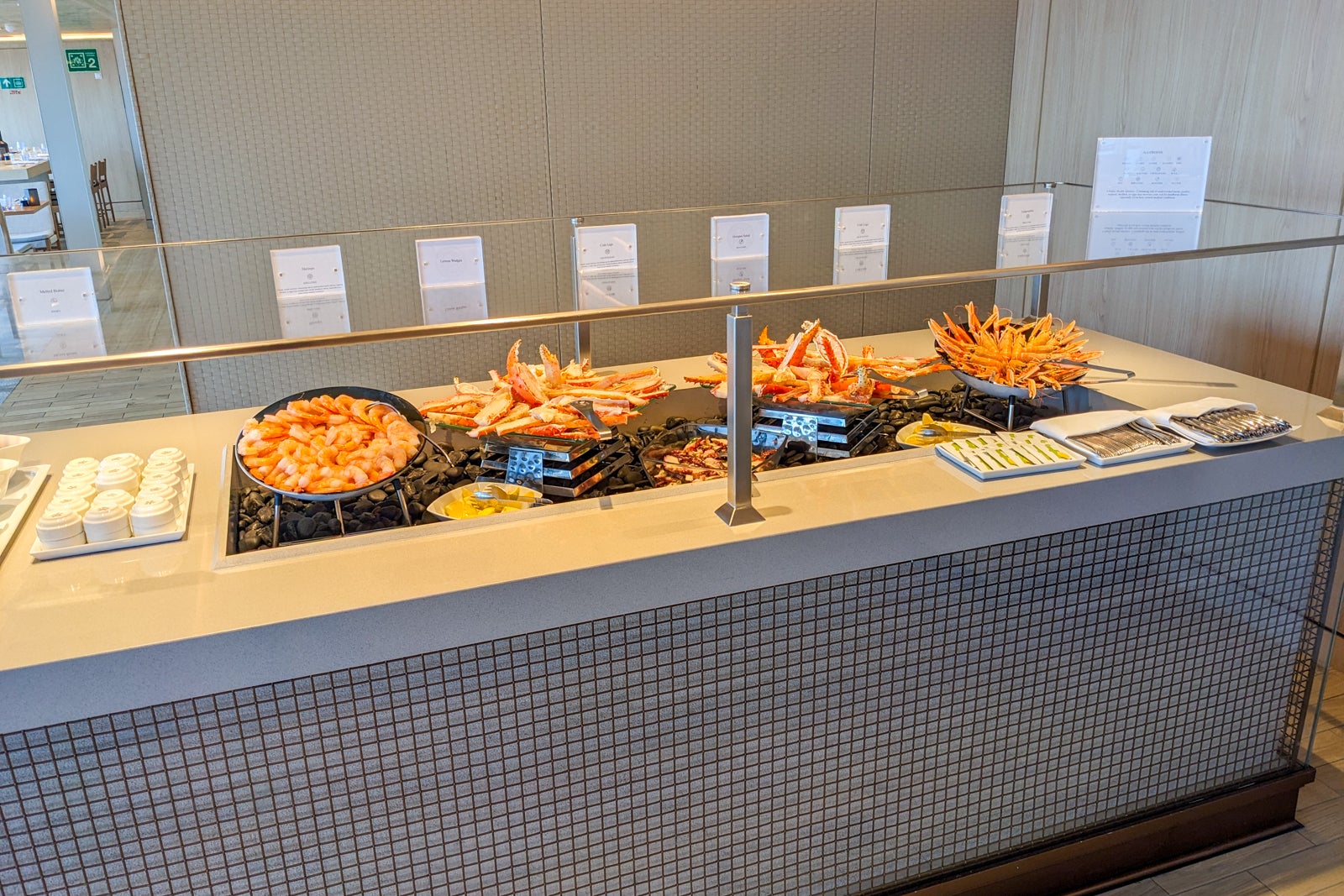
If you don’t see what you’re looking for, don’t hesitate to ask one of the dining staff either behind the buffet counter or walking the seating area. Crew members brought us plain grilled chicken to top a salad, a vegetarian “meatball” when the meatless options were lacking and coconut gelato when it didn’t appear at the ice cream bar.
Dinner is a similar affair with hot options, pizza, a made-to-order counter (often a noodle soup), a Caesar salad bar with additional pre-prepared salads and desserts, including a nightly warm option (like peach crumble or bread pudding) and Coldstone-style mix-in ice cream rolls. The main addition is a nightly sushi bar and seafood buffet (lots and lots of crab legs) in the back by the Aquavit Terrace on the port side of the ship.
I loved that if you’re lingering over a meal toward the end of service, a waiter will come by and alert you that the buffet is closing, so you can grab seconds or dessert before it’s too late.
On the far starboard side of the World Cafe is the Grill. It serves sandwiches by day (multiple types of burgers, veggie burgers, chicken sandwiches and tuna steak) and cooked-to-order meats at night (steak, brisket, burgers, swordfish). You can ask for sides from onion rings and French fries at lunch to roasted potatoes and asparagus at night, or forage for accompaniments from the rest of the buffet.
We spoke to a few diners who said the default is to cook the meats well, so if you prefer yours medium or rare, be very clear about that.
Viking Polaris’ two sit-down restaurants are The Restaurant and Manfredi’s, both on Deck 1 and only open for dinner. The Restaurant is a typical cruise ship main dining room with a menu split into always-available classics and the daily dinner menu that changes each evening. It’s a three-course meal (though you could order more) with starters, mains with sides and dessert.






The daily menu might include leek and potato soup or beef tartare as a starter, seared sesame-crusted tuna or roasted veal medallion for a main, and peanut butter cheesecake for dessert. Note that many of the menu items at The Restaurant will also be available at the World Cafe upstairs.
Always-available dishes include Caesar salad and chicken soup, beer-marinated chicken and New York strip steak, an iced vanilla parfait and a cheese plate.

Manfredi’s is the ship’s Italian restaurant and the hottest dinner reservation on board. It’s less accommodating of walk-ins so make your bookings early. If you have a special occasion to celebrate, you’ll want to do it here.
The menu is divided into many sections and can be overwhelming at first, but it’s not as complicated as it looks. Starters include antipasti, caprese salad, beef carpaccio and asparagus topped with a poached egg. You also have a choice of two soups. The pasta selection is not to be missed, especially the gnocchi in a gorgonzola cream sauce. You can ask for half or full sizes and enjoy the handmade pasta as a starter or main.
Main dishes come in two varieties. Piatti unici come as complete dinners with a protein and vegetable side, while secondi piatti are only the protein and you choose your sides. For example, I ordered the sliced grilled duck breast and it came plated with a salad, but if I’d ordered the Florentine steak or grilled tuna, I would want to also order some sauteed mushrooms or new potatoes with truffles and rosemary.






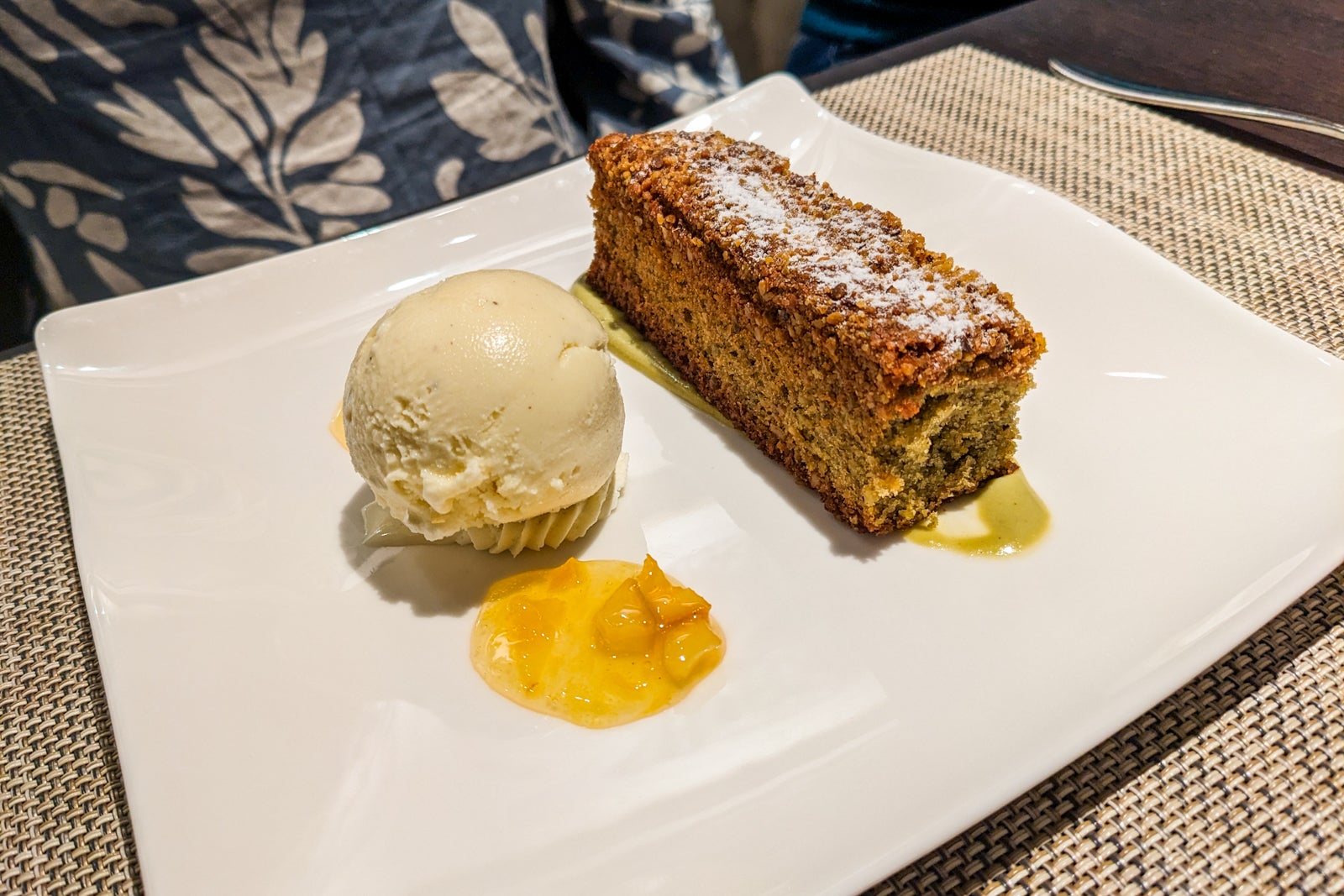
Don’t worry — you can order sides even if you choose a pasta or pre-assembled dish as your main.
Desserts include tiramisu, panna cotta and pistachio cake, as well as a selection of gelato. I’d recommend the pistachio cake with a scoop of vanilla gelato.
Most cruisers can make one reservation at each restaurant prior to the cruise, but suite guests can make two to four pre-cruise reservations per venue, depending on the suite category booked. Anyone can make additional reservations online or try their luck with a walk-in if there’s space available. We’ve heard it’s easier to get seats at The Restaurant than at Manfredi’s.
If you have a large group, you can reserve the private dining room between The Restaurant and Manfredi’s. It seats 12 at one long table and is surrounded by racks housing the ship’s wines. It’s ideal if you want to have a rowdy group dinner without disturbing other diners, but it’s a poor choice if you enjoy the scenery during dinner as the room has no windows.



Open for breakfast, lunch and afternoon snacks, Mamsen’s is a cute cafe serving Norwegian specialties inspired by the recipes of the mother of Viking’s founder. The stars of the show here are the Norwegian waffles you can top with sweet brown cheese, berry compote or chocolate sauce, hot dogs served on flatbread, pea soup and open-faced sandwiches.
Viking’s expedition ships do not serve a fancy afternoon tea like its ocean ships do, but you can find scones with clotted cream and jam served here in the afternoon.
As a special treat, the dining staff might host a barbecue lunch on the top deck (6) on a day when the weather is sunny. It’s a fun, festive alfresco meal, but you won’t get much notice and might have to adjust your landing times if you don’t want to miss it.



Our barbecue was a meaty affair with chicken wings and pork ribs as an appetizer and a choice of steak or sea bass, with baked potatoes and cole slaw, as a main. We were initially told there was no vegetarian option, but the server came back saying they could get a veggie burger from the grill. If you’re looking for something lighter or more vegetable-forward, the World Cafe remains open.
Room service is complimentary and available around the clock. Your room steward will leave you a breakfast card to hang outside on your door knob, for delivery between 6 and 10 a.m. Choices include beverages, fruit, yogurt, cereal, pastries and bread, cold cuts and cheeses, eggs, pancakes and breakfast meat.

The all-day menu is in a leather binder on your cabin’s coffee table. It’s a limited menu, which includes salads, soups, mains (steak, poached salmon, southern fried chicken), sandwiches (caprese, beef or veggie burger), spaghetti, a cheese plate and dessert (vanilla cheesecake or bourbon pecan brownie). You can call your order in on your in-room phone.
Everyone agrees that the fried chicken and the chicken noodle soup from the room service menu are not to be missed.
Bars

I’m not much of a drinker, but the bars and lounges on Viking Polaris are so comfy and inviting that I found myself looking forward to a pre-dinner cocktail or evening hangout in one of the ship’s bars more than I do on other cruise lines. Viking guests can either purchase drinks a la carte or buy the Silver Spirits beverage package. All passengers can order complimentary wine, beer and soft drinks at lunch and dinner.
The cocktail menus at the bars are composed of standard drinks, but bartenders can make you your favorites off menu if they have the ingredients. We successfully ordered Pimm’s Cups and Lemon Drops, but a Dark n Stormy and Moscow Mule were no-go’s because the ship does not carry ginger beer. (And here I thought a Dark n Stormy would be a perfect Drake Passage drink!)
My favorite bar for atmosphere is The Hide on Deck 1. It feels like a speak-easy because you can only access it from Deck 2’s forward stairwell or elevator.

You open a heavy door that looks like it belongs on a submarine to enter a dimly lit space with slanted windows on either side with views close to the water line. The clusters of couches and easy chairs invite confidences with newfound friends, while the oversized cushion chairs by the windows will tempt you into an afternoon nap, lulled by the rocking of the ship. The large columns at the front of the space actually house the anchor chains.
It also has a speakeasy-style bar, serving liquor-forward drinks (either your favorite liquor straight or on the rocks or with a light mixer, like soda water). You won’t find wine, beer or daiquiris here. The small bar is only staffed for a limited time each evening after dinner.
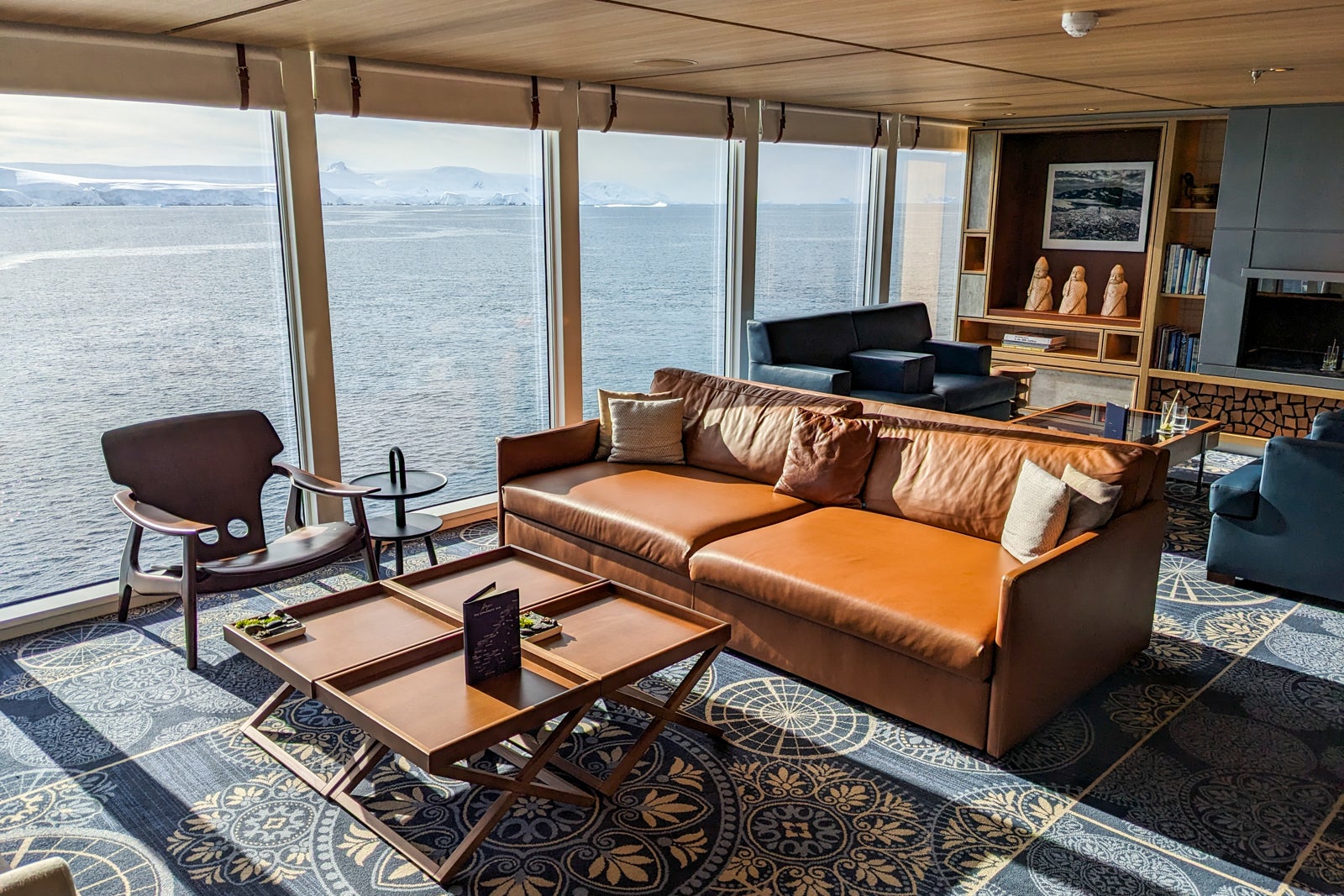

For views, you can’t beat the two-deck Explorers’ Lounge on decks 4 and 5. Both levels face the front of the ship with floor-to-ceiling windows and wraparound views. When you want to look for whales but don’t want to brave the wind, the Explorers’ Lounge is a great choice. The bar is on the lower level, but both levels offer cozy seating, both facing the windows and in conversation nooks.


An equally cozy spot is The Living Room on Deck 5. It has a bar but serves more as a comfortable hangout space with a library, digital game tables, puzzles and a large TV showing Viking channels.
As is common on this ship, glass windows run the length of both sides of the space so you’re never far from the scenic views. Events like team trivia take place here. The Living Room’s bar opens early, should you be looking for coffee drinks from an espresso machine, and closes mid-evening.

The Aquavit Bar between the World Cafe and Aquavit Terrace serves diners at the buffet restaurant, as well as guests relaxing in the aft solarium space. It closes at the same time that dinner shuts down.
The Viking Bar on Deck 1 is your pre-dinner drink spot when you have a reservation at The Restaurant or Manfredi’s. It’s only open during dinner hours, from 5:30 (half an hour between the restaurants open) to 9 p.m.
If you need a quick cuppa or to refill your water bottle, self-service coffee/tea/water stations are located around the ship. You’ll find them on Deck 2 outside The Aula and outside Expedition Central and in the World Cafe.
Viking Polaris activities and entertainment

As the crew likes to say on Viking Polaris, the ship has no official entertainment staff because the outdoors is providing the main entertainment on an expedition cruise. The ship’s Grand Central station for outdoor adventure activities is The Hangar. That is where you will board the ship’s Special Operations Boat or Zodiac boats (rigid inflatable motorized rafts) for cruises, landings and to be taken to waiting kayaks and submersibles (named Ringo and George because the subs are yellow).
The Hangar is arranged so it’s as easy as possible to board the Zodiacs. No gangways are employed. Instead, you step from an open door onto a step in the Zodiac and then into a boat, with at least two crew members assisting you in and out every time. The Hangar also employs a state-of-the-art boot brushing and sanitizing machine (imagine walking your feet through car wash bristles) to make it easy to clean boots on the way to and from polar landings.


Viking does not schedule polar plunges for safety reasons (both yours and Antarctica’s), so you will not cross that activity off your bucket list on a Polaris sailing.
Even though your focus will be on shore and sea excursions, you’ll still find plenty to do on board.
Viking puts an emphasis on enrichment and education, and you’ll find yourself often in The Aula, the theater based on a famous Norwegian lecture hall. It has a giant video screen that can roll up like a garage door to uncover the huge windows behind it. Warm throw blankets in every row are a cozy touch.


Here, the expedition team will give daily briefings about weather conditions and upcoming landing sites, give talks on the area’s wildlife or culture, and show documentaries and videos related to the destination.
Some talks (including an entertaining one on nautical superstitions) are held in the Hide. Arrive early because seats are limited, and latecomers might have to stand in the back or sit on the floor.
The ship also has a science lab, and guests can participate in real experiments and data collection during their voyage. You can find an interactive map and often an expedition team member to talk to at Expedition Central on Deck 2.


But it’s not all serious edutainment. A dance party with some complimentary cocktails is held in The Living Room one evening and a music variety show takes place in The Aula.
On the more relaxing side, Viking Polaris has a world-class Nordic Spa with a gorgeous thermal suite. The thermal suite features numerous hot and cold therapies (including a snow room, sauna and a hot tub with an open window to the polar breezes outside), a therapeutic pool and stunning views through floor-to-ceiling windows. It’s the perfect place to warm up after a cold Zodiac ride or landing, so it can get crowded in the afternoon.


Book a mani-pedi or style session at the salon, and you’ll also be able to take in the views while you’re pampered.
Spa treatments have a Nordic twist, but you’ll find all the massages, facials and body treatments you could want. Try the Hygge massage in a warm “sand” bed — it’s a Viking specialty. My Nordic stone massage was one of the best massages I’ve ever had, and my masseur, Joksim, knew what my stressed-out body needed and worked out all my knots. Ladies should note that many of Viking’s spa therapists are men if that’s something that makes you uncomfortable.
The two-room fitness center is small by big-ship standards, but it still manages to fit three treadmills, two elliptical trainers, two stationary bikes, an erg, resistance machines and weight benches with free weights. In the group exercise space, you can take classes, use the yoga and bosu balls on your own, or access a range of digital exercise classes on the large-screen TV.

The gym is most crowded early in the morning before the day’s briefings, lectures and expedition activities get going. If you want to work out with the crew, time your workout for prime dinner hours.
The ship has multiple outdoor spots for nature gazing and alfresco relaxation. The Bow on Deck 3 is a great forward-facing spot to look for whales or watch the ship’s arrival at a landing area. It’s adjacent to the Shelter, a covered spot to take refuge from the wind or rain (and occasionally snag an Irish coffee on a special occasion).
The Finse Terrace on Deck 2 aft, outside The Aula, has two fire pit areas for serious chilling.




The Aquavit Terrace on Deck 5 aft has a warm pool surrounded by lounge chairs and covered by a retractable glass roof. The glass window at the end of the pool opens up, so you can swim out to an uncovered section of the pool. On either side are two outdoor tubs — one hot, one cool. There’s nothing better than soaking in a hot tub on a sunny Antarctic day with snow-covered mountains and icebergs all around you.
The promenade on Deck 5 is a lovely place to walk, though you’ll have to go down to Deck 4 and back up again at the front of the ship to complete the loop. Deck 6 is an open deck where you can lounge on warmer itineraries or scan for wildlife on cold ones.

If you want to buy gorgeous Norwegian sweaters like the expedition crew wears, adorable penguin beanies and the softest stuffed puppies, visit the Nordic Shop on Deck 3 midship when it’s open. It also sells items you might have forgotten, such as toothpaste or hand warmers. The hottest items here are the Antarctica patches you can attach to your Viking-provided jacket. If you want one, come when the shop opens as they can sell out.
Guest services include a medical center on Deck A, a travel consultant (to book your next Viking river, ocean or expedition cruise) on Deck 3 across from the shop and guest services desks on Deck 1 outside Manfredi’s.
Guest launderettes on decks 3 and 4 have washers and dryers, irons and ironing boards, and detergent is provided. Be sure to set a timer and remove your items promptly. The launderettes are popular on long cruises.
Viking Polaris itineraries and pricing

Viking Polaris currently spends the North American winter in Antarctica and the summer in the Great Lakes, transitting between the two in the spring and fall. The one-way repositioning voyages take passengers along the coast of Chile, through the Panama Canal, along the Eastern Seaboard of the U.S. and Canada then into the St. Lawrence Seaway.
In 2026, the ship will spend the summer months sailing Iceland and Greenland cruises in the Arctic instead of the Great Lakes.
Viking expedition cruises tend to be long, and many itineraries are combinations of multiple cruises that could be booked separately. Travelers pressed for time can book a seven-night Great Lakes sailing, but the shortest Arctic and Antarctic cruises are at least 12 nights. Many itineraries are two weeks or longer. To sail between Milwaukee, Wisconsin, in the Great Lakes to Ushuaia, Argentina, at the southern tip of South America takes just over 60 days.
A 12-night Antarctic Explorer cruise starts at $11,995 per person in the lowest-tier Nordic balcony cabin. A weeklong Great Lakes cruise starts at $5,995 per person. A 12-night Arctic sailing starts at $13,995. Fares go up for more popular sail dates and for larger and higher-category cabins.
Related: The 5 best destinations you can visit on a Viking ship
What to know before you go
Required documents
Required documents will vary depending on your cruise destination, but you will definitely need a passport.
If you’re traveling to Antarctica or the Arctic, you will need a medical form signed by a doctor, clearing you to travel. Submit that at least 30 days prior to sailing. You must also fill out a form pre-cruise to request the correct size of jacket, pants and boots for your expedition.
Gratuities
Viking automatically adds a $17 gratuity per guest, per day, to your onboard bill. It is shared among the room stewards, waiters, galley staff and housekeeping. If you must change the amount, you can do so at Guest Services; you’re always welcome to leave additional tips in cash or hand them to your favorite crew members.
I asked, and it is acceptable to tip expedition staff, in addition to waiters, bartenders and room stewards. Spa treatments do not automatically add a gratuity to your bill, but you can leave a tip when you’re signing after your treatment.
Wi-Fi
Wi-Fi is included in the cost of your cruise. Viking uses a VSAT satellite terminal to provide the connection, and it was impressively good. I was able to make several WhatsApp Wi-Fi video calls back home from Antarctica, and though the image wasn’t perfect, I could still show my kids penguins swimming off the side of the ship.
Carry-on drinks policy
Viking has a generous alcohol policy. All passengers are allowed to bring alcohol and other beverages on the ship with them, and they won’t be charged a corkage fee, regardless of whether they drink their beverage in their room or in a lounge or restaurant.
Smoking policy
Viking Polaris is a nonsmoking ship, and you cannot smoke indoors or on most outdoor decks. The only place you’re allowed to smoke cigarettes, cigars and e-cigarettes is in the designated smoking area outside on the starboard side of Deck 6.
If you’re cruising in polar regions, you should also be aware that smoking is not allowed ashore anywhere in Antarctica or in Svalbard in the Arctic.
Laundry
Viking Polaris has two self-serve launderettes on decks 3 and 4. Each features multiple washers and dryers you can use free of charge; detergent is provided. Irons and ironing boards are also available, but you can only use them in the launderette.
Alternatively, you can send out clothes to be washed and dried, pressed or dry cleaned for a fee. A bag is provided in your room, and you can select regular two-day service or same-day service for a 50% surcharge. Prices are per item, not per bag.
If it’s been a while since you’ve used communal laundry rooms, you will need to dig deep and remember your college laundry etiquette. Set a timer on your cellphone so you can switch your laundry promptly. Fail to do so and another guest is likely to dump your wet laundry onto the ironing board.
We overheard several heated discussions about who had rights to which dryers and when. Don’t wait until the last day of your trip to do your washing, as that’s when the launderettes are the busiest.
Electrical outlets
Viking Polaris is a 21st-century ship, so you can expect more than just one outlet. Each nightstand features a three-part power strip with a U.S. 110-volt, European 220-volt, USB and USB-C outlet, as well as a wireless charger, should your phone have that capability (mine did not). Note that when you plug a charger into the 110-volt outlet, it blocks the regular USB outlet, but not the USB-C.
The desk area has two 110V and two 220V sockets. There’s also a 220V outlet outside the bathroom, should you wish to plug in your own nightlight, and a shaver outlet inside the bathroom.
Currency
The onboard currency is the U.S. dollar. You won’t be paying for much — mainly souvenirs, drinks and spa treatments. You’ll be asked to provide a credit card, and your onboard bill will be charged to that account.
Drinking age
The drinking age on board is 21, regardless of where Viking Polaris is in the world.
Dress code
Expeditions are casual affairs. You will be so anxious about bringing the correct polar gear that onboard attire is almost an afterthought.
Daytime attire on the ship is a mix of casual outfits based on the weather (jeans, slacks, sneakers, etc.) and adventure attire (leggings, fleece vests or jackets, athletic pants). One guy on our Antarctica sailing was often seen in a tropical shirt and shorts. The spa’s changing areas are small, so you’ll also see people walking the ship in their bathrobes or workout wear on their way to and from the Nordic Spa.
If you don’t want to change for dinner, your casual daywear is appropriate at the World Cafe in the evening. No one will blink if you show up in a fleece jacket and hiking pants or athletic leggings and a top. Only swimwear, PJs and true exercise attire (like a sports bra with bike shorts) would not be acceptable. And, yes, we did witness a guest being ever-so-politely encouraged to leave the World Cafe when he showed up in his bathrobe.
Related: Antarctica gear guide: What you need to pack for a trip to the White Continent
If you wish to dine at The Restaurant or Manfredi’s, you are supposed to step it a notch. Viking considers evening dress in the restaurants “elegant casual” — aka, no jeans. The suggested attire is slacks and a collared shirt for men and nice slacks, a skirt or dress for women. However, we saw diners dressed more casually (fleece jackets and jeans) in both restaurants, and no one said a word.
Viking Polaris does not have any formal evenings, so leave your cocktail dresses, suits and neckties at home.
Bottom line
If you want to visit the ends of the earth without giving up creature comforts, Viking Polaris is the perfect ship for you. Its large-for-expedition size means the ship is loaded with attractions, from multiple restaurants and lounges to an expansive spa, spacious cabins and dedicated spaces for enrichment activities. Its state-of-the-art Hangar allows travelers of all abilities to access off-ship adventure and its expedition team to set up water- and land-based activities as quickly as possible.
However, if you want to spend as much time as possible off the ship in polar regions, you might do better, especially in Antarctica, with a ship that carries closer to 100 passengers. The trade-off is that you might have to choose a ship that has fewer frills and amenities than Viking Polaris.
Plus, it’s unclear that any expedition ship has a crew as friendly, knowledgeable and helpful as the folks who work aboard Polaris. They make the trip more special than any ship designer or rare penguin could ever do.
Planning a cruise? Start with these stories:
- The 5 most desirable cabin locations on any cruise ship
- A beginners guide to picking a cruise line
- The 8 worst cabin locations on any cruise ship
- The ultimate guide to what to pack for a cruise
- A quick guide to the most popular cruise lines
- 21 tips and tricks that will make your cruise go smoothly
- Top ways cruisers waste money
- The ultimate guide to choosing a cruise ship cabin


